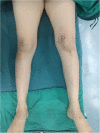Anesthetic management of a patient with limb-girdle muscular dystrophy 2B:CARE-compliant case report and literature review
- PMID: 31421689
- PMCID: PMC6698341
- DOI: 10.1186/s12871-019-0813-8
Anesthetic management of a patient with limb-girdle muscular dystrophy 2B:CARE-compliant case report and literature review
Abstract
Background: Limb-girdle muscular dystrophies (LGMDs) belong to few neuromuscular disorders mainly involving pelvic and shoulder girdle muscles. Also, cardiac or pulmonary complications, increased rhabdomyolysis risk when exposed to volatile anesthetics and succinylcholine may increase anesthesia related risks. However, current reports about the anesthesia management of these patients are limited.
Case presentation: We described our anesthetic management of a 36 years old woman with LGMD 2B receiving arthroscopic knee surgery. In consideration of the high risk of rhabdomyolysis, total intravenous anesthesia (TIVA) was selected for her surgery. Considering the unpredictable respiratory depression, opioid based patient-controlled intravenous analgesia was replaced with an intra-articular cocktail therapy consisting of 20 ml of 0.2% ropivacaine. Also, we reviewed the literatures on anesthetic management of LGMD through searching PubMed, in order to provide a comprehensive and safe guidance for the surgery.
Conclusions: Carefully conducted general anesthesia with TIVA technique is a good choice for LGMD patients. Neuraxial anesthesia may be used if general anesthesia needs to be avoided. To warrant safe anesthesia for surgery, any decision must be well thought out during perioperative period.
Keywords: Anesthesia; Limb-girdle muscular dystrophy 2B; Surgery.
Conflict of interest statement
The authors declare that they have no competing interests.
Figures


References
-
- Iyadurai SJ, Kissel JT. The Limb-Girdle Muscular Dystrophies and the Dystrophinopathies. Continuum (Minneap Minn) 2016;22(6, Muscle and Neuromuscular Junction Disorders):1954–1977. - PubMed
Publication types
MeSH terms
Substances
Supplementary concepts
LinkOut - more resources
Full Text Sources

